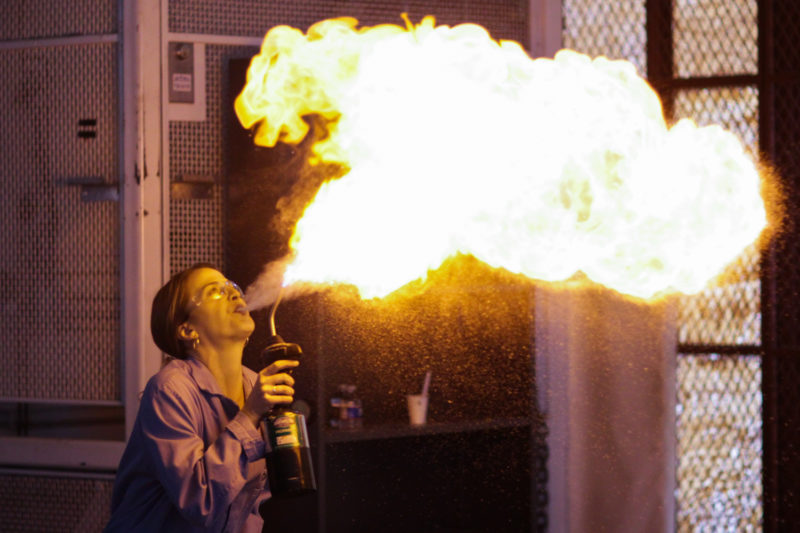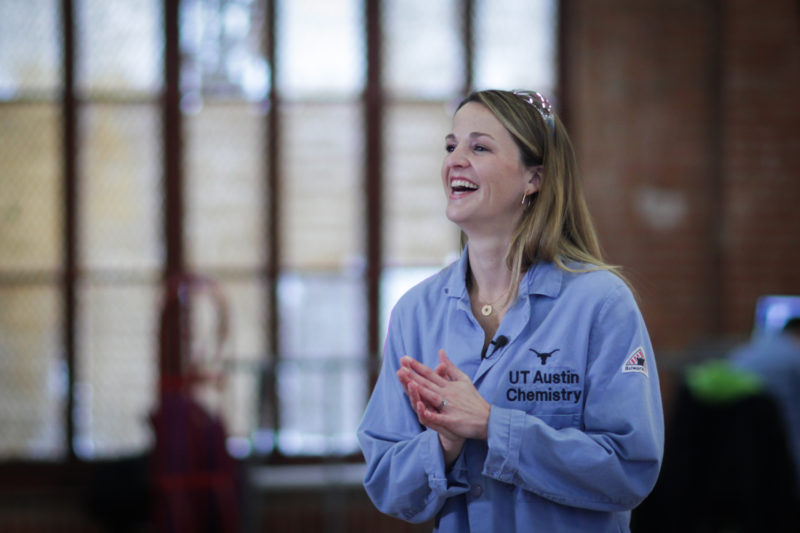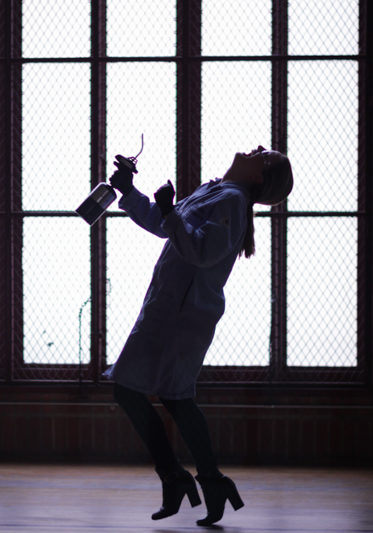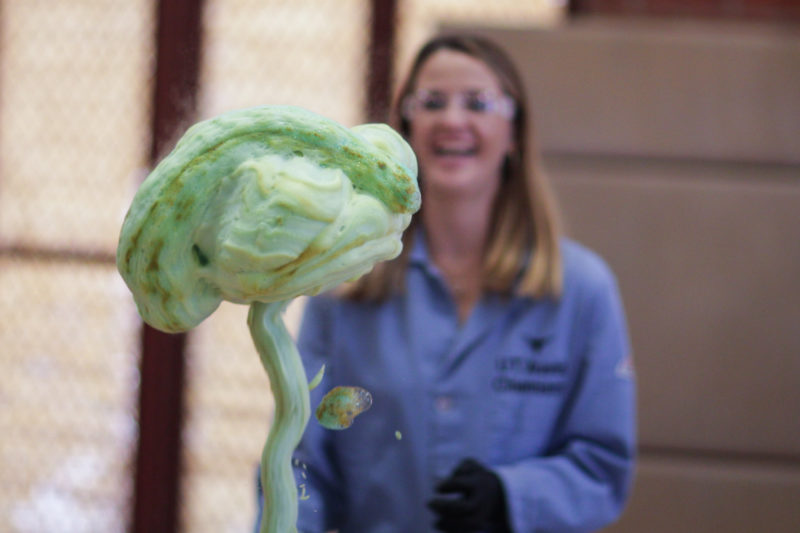Playing with Fire, UT Professor Sparks Interest in Chemistry (and Sometimes Things Explode)
By Alexia Puente
Reporting Texas

Biberdorf performs her fire-breathing demonstration by blowing a mouthful of cornstarch through a blowtorch flame. Eric Vela/Reporting Texas.
As a young girl, Kate Biberdorf played scientist in her bathroom in Kalamazoo, Michigan. Her mother would set up a “laboratory” with shampoos, soaps and food coloring, letting Biberdorf and her sister create a rainbow of bubbly froth and foam.
Biberdorf decided at the age of 15 to become a chemist. She especially loved the ubiquity of chemistry – how it explains the ins and outs of everything in life.
Now, at the age of 31, Biberdorf teaches chemistry at the University of Texas and runs an outreach program where she demonstrates science experiments for K-12 students. She has also made multiple TV appearances as “Kate the Chemist,” a fun-loving, fast-talking scientist who wants to show the beauty of chemistry to everyone.
“I absolutely think it’s important for people to have role models and mentors and be inspired to be a best version of themselves,” Biberdorf says.
Biberdorf has taught Principles of Chemistry I and II as well as a class called Chemistry in Context at the University of Texas, where she has been on the faculty since 2014. Her inspiration came from her own fun and energetic chemistry teacher in Kalamazoo, who always taught the class with infectious enthusiasm. Biberdorf recalls looking forward to her class because the teacher ran around the classroom, spoke passionately about chemistry and blew up things in experiments.
After earning her degree in chemistry at the University of Michigan, Biberdorf moved to Austin in 2008, where she entered the University of Texas’s graduate program for inorganic chemistry. She became an introductory chemistry lecturer at UT after she earned her Ph.D. in 2014.
Biberdorf has moved on up from the days of “playing” scientist, bringing her chemistry lab demonstrations on stage during the Wendy Williams Show, where she created a giant “thunder cloud” as she poured liquid nitrogen into a bucket of boiling water. Following that appearance, she was invited to the Late Show with Stephen Colbert on July 14 becoming the first female scientist to perform on late night television. They set balloons on fire and breathed fire on stage by spewing cornstarch onto a blowtorch. Many students who watched recognized these demos; a self-described “pyromaniac,” Biberdorf demonstrates these experiments in her classroom, where her aim to build a “STEM army” has turned her into a celebrity.

Biberdorf prepares to shoot a video in the Anna Hiss Gym on UT campus to promote a classroom version of Minecraft to teachers. Eric Vela/Reporting Texas.
“If you’d asked me 10 years ago if I was going to be doing something with Stephen Colbert or Wendy Williams, I honestly would’ve never expected that,” Biberdorf says regarding her newfound fame.
Her lectures begin with music blasting as students walk into the classroom. Once Biberdorf shuts off the music, she has the attention of over 500 students.
Biberdorf paces around the room, asking students to provide explanations for the concepts that she’s gone over. The teaching assistants throw candy to students who give correct answers. In the middle of one lecture, Biberdorf warns her students to cover their ears as she blowtorches hydrogen-filled balloons filled with different inorganic salts. The explosions display different colors and add flare to the presentation as they represent combustion reactions.
Biberdorf describes herself as an individual with a lot of energy who “desperately needs to be kept busy at all times” She has a small gym in her home. She enjoys traveling, caring for her dog, Betty, and baking (especially the chemistry involved).

Biberdorf shows off one of her celebration dances, well-known to her students, that can be seen whenever a successful lab demo excites her. Eric Vela/Reporting Texas.
In the fall semester of 2014, she asked the chairman of her department for an extra project and inherited the UT Chemistry Demonstrations Program. From there she was able to start her own outreach program known as Fun with Chemistry.
Fun with Chemistry was created to inspire a love for science in students in elementary, middle and high school. Biberdorf travels to schools in Austin to give a lecture and performs demonstrations in auditoriums filled with 100 to 500 students. One of the most requested demos is her combustion lecture, where she blows up hydrogen balloons, bottle rockets and fireworks. She also does hands-on demonstrations with groups of 10 to 30 students, where they get to work on experiments such as learning the phases of matter through creating slimes, sand and other substances.
Biberdorf started hosting Fun with Chemistry at local schools in Austin but has since traveled to schools all over the nation. Her goal is to interact with every student in Texas.
“If you keep going back to kids you interact with, there’s a good chance you can make a difference in their life,” Biberdorf says.
She has made a difference in the lives of students at UT. Senior and undergraduate teaching assistant Jacks Reyna become a volunteer for Fun with Chemistry three years ago. After a year of attending many shows on and off campus, Reyna asked to become an intern for her program in the fall of 2016.
Initially a neuroscience pre-med major, Reyna switched to chemistry after working with Biberdorf. He’s adopted her love of setting experiments on fire, even getting into fire-breathing contests with “Dr. Dragon,” and he now has more opportunities to help with demonstrations after being promoted to Fun with Chemistry’s first demonstrations teaching assistant position last January.
“At first, I did not think I would ever be able to be a science major, and much less a chemistry major,” Reyna says. “My life would be so boring if I didn’t have chemistry in it now.”
Jordan York, a chemistry junior and current teaching assistant for Biberdorf’s chemistry course, has also been able to work with the outreach program as well as their yearly summer camp. These are day camps are for students from fourth to eighth grade that take place on the UT campus, allowing kids an opportunity to work hands on with experiments, work with other students and learn from Biberdorf herself. While there are fees for the summer programs, the funds allow for Biberdorf to run the outreach program for free during the fall and spring semesters, as well as offer scholarships to aspiring science students.
York says that she and another intern helped Biberdorf with the development of a two-day forensic science camp this past summer after discovering a shared love of listening to true crime podcasts. Kids were taught fingerprinting and blood analysis and worked with crime dogs. They used their newfound skilled to solve a “kidnapping” during mock crime scene.
David Vanden Bout, the Associate Dean for Undergraduate Education at UT, says that Biberdorf is a great ambassador for science and the university as her outreach work brings the joy and excitement of science to a broad range of people who are often not exposed to science.
“Dr. Biberdorf embodies several values of the College of Natural Science. She is making learning about chemistry fun, and she is also very intentional in her inclusivity and makes sure that science is open and accessible to a wide audience,” Vanden Bout wrote in an email. “We are also lucky to have her teaching introductory chemistry courses where she brings her knowledge, enthusiasm and love of chemistry to a new generation of college students at UT-Austin.”
While Biberdorf’s goal is to get every student she can interested in science, she says that it’s especially important to advocate for girls in science and dismantle the stigma around it.

The “elephant toothpaste” experiment is created by adding potassium iodide to hydrogen peroxide mixed with dish soap. Eric Vela/Reporting Texas.
“I’ve talked to a lot of mothers who would say ‘I would never put my daughter in your science camp.’ That’s hard for me. I feel like I’m their 7-year-old daughter’s advocate,” Biberdorf says.
According to the Unesco Institute for Statistics, fewer than 30 percent of the world’s researchers are women. In the United States, women make up 38.3 percent of chemists and materials scientists. A report issued in 2010 by the American Association of University Women shows that stereotypes and gender biases are a large contributing factor in why girls and women are pushed away from math and science. Even those who advocate against the stereotypes, such as the misbelief that boys are better in math and science than girls, can unconsciously hold an implicit bias due to societal influence.
York says that working alongside Biberdorf, who often wears high heels to her lectures, showed her that being unapologetically feminine and loving science weren’t mutually exclusive. York entered UT as a psychology major and was unsure of what to do with it. She is now a chemistry major with plans to attend graduate school.
“Dr. B showed me that I could like high heels and blowing stuff up. I have direction and a sense of purpose and I can’t thank her enough for helping me realize what I want to do in the future,” York says.
After her appearances on television, Biberdorf’s platform has allowed her to communicate with more people than ever before. Having cultivated thousands of followers across her social media platforms, Biberdorf not only shares her science experiments (such as making a carved pumpkin “vomit” using chemical compounds), she also shares scientific data and provides explanations to her followers. She does not shy away from controversial topics, such as climate change, and is very vocal about wanting women to pursue STEM.
“I’m a little nervous about it, I have to be honest, because you know as soon as you start talking about climate change or anything that has to do with politics you open yourself up for the haters and the trolls,” Biberdorf says. “Unfortunately, one of the first responses I got to my segment on the Colbert Show was that I should get back in the kitchen.”
Her newfound fame has led to her being recognized in public, and people who come up to her are usually overjoyed. She been thanked for advocating for women in stem and “loves that moment” when she knows that people have been watching her segments of setting explosions, creating giant clouds and breathing fire like a fire-breathing dragon.
She advises women who are looking into STEM to plow ahead and not let any negativity from classmates, professors or employers stop them from following their passions. Biberdorf wants to see women, women of color, and everybody to be represented in the STEM field.
“You cannot give up on your passion for science, please, whatever you do,” she says. “I just want them to see that here I am, a professor of chemistry, and I love the science, I love this field and I’m also a woman and I’m having a great time and hey you can do it too.”
She adds: “It doesn’t matter who you are, what you look like, who you love — it doesn’t matter. Anybody can be a scientist.”